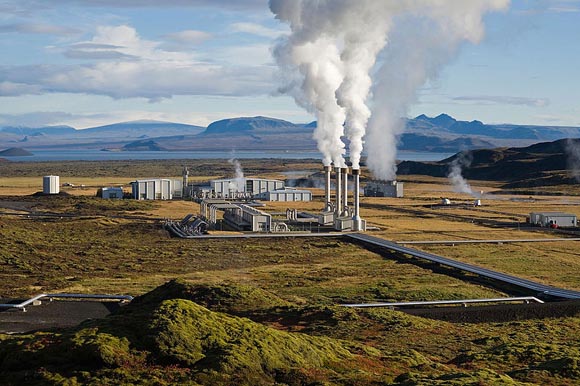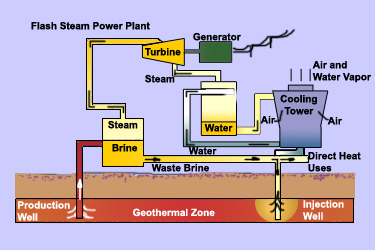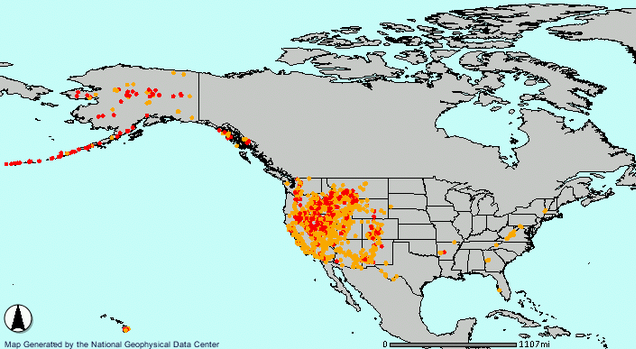Geothermal Power

A geothermal power plant in Iceland. Only steam comes out of the smokestack. |
Remember the sidewalks of Klamath, Oregon? They are warm on snowy days. Their source of warmth is geothermal power. Geothermal power (from "geo" for earth and "thermal" for heat) consists of energy stored in soil, underground rocks, and fluids in Earth’s mantle. In general, rock temperatures increase as you move downward through Earth’s interior. The rate of this temperature increase the further you go down is known as the geothermal gradient. Just 300 to 400 feet down, the temperature becomes quite warm. Once you get about 10,000 feet below Earth’s surface, the temperature is hot enough to boil water.
Sometimes water makes its way close to the hot rocks and magma below Earth’s surface. The hot magma can heat the water to boiling and that water makes its way back up to Earth’s surface through openings in the Earth’s crust. In parts of the world where geological conditions are right to produce this type of activity, the heated water can be withdrawn and used to turn a turbine, just like in coal-burning power plants. Except, in these cases, no fuel is burned because the water is already hot. Click through the tabs to learn more about geothermal power.
Geothermal Power Plants

At a geothermal power plant, hot water is withdrawn from deep inside Earth through a production well. The water is hot and under great amounts of pressure. Through a process called flashing, the pressurized water is converted to steam. The steam turns a turbine and generates electricity production at a generator. After the steam is used, it cools, is collected in a cooling tower, and then gets pumped back down into the ground to replenish the water that was initially withdrawn. This way no water is wasted and the supply of hot underground water does not run out.
Where Geothermal Power is Used

Geothermally-heated water is closer to Earth’s surface in some places than it is in others. Countries that have the best access to geothermal energy are Iceland, Chile, the U.S., the Philippines, Italy, and New Zealand.
In the U.S., geothermal electricity is generated in five states: Alaska, California, Hawaii, Nevada, and Utah. As of 2007, there were plans to build new geothermal power plants in seven other states with suitable geologic features, mostly in the western part of the country. The Energy Policy Act of 2005 makes geothermal plants eligible for federal tax benefits, giving a boost to geothermal energy in the U.S. The United States generates an average of 15 billion kilowatt hours of geothermal power per year. This is comparable to burning some 25 million barrels of oil or six million short tons of coal per year.
Six million Americans get their electricity from geothermal energy. In 1999, Santa Monica, California became the first city in the U.S. to get all its electricity from geothermal sources.
Advantages and Disadvantages of Geothermal Power
Advantages of Geothermal Energy |
Disadvantages of Geothermal Energy |
Very high energy efficiency and renewable |
Scarcity of suitable sites |
Lower carbon dioxide emissions |
Odor pollution (the hot water often smells like rotten eggs) |
Low land use |
Reservoirs can be depleted if used faster than renewed |
Low land disturbance |
High cost at less than favorable sites |
You got it! Like everything else we have discussed in this section on renewable energy, geothermal energy has its own pros and cons. The table sums them up for you.